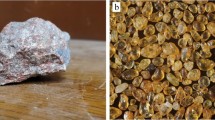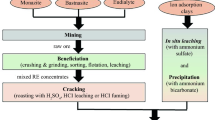Abstract
The broad field of extractive metallurgy, often perceived as an unimportant point of light in the universe of technology, has undergone significant, fundamental changes in the past 30 years. Improved extraction technologies now permit greater metal recovery, reduce the time that metal values are chemically locked up and diminish the economic impact of environmental regulations. Much of this accomplishment is due to the application of solvent extraction. As evidenced by improvements in the extraction of rare and precious metals, research in extractive metallurgy technology not only exists, but has achieved palpable results.
Similar content being viewed by others
Bibliography
Abe, H., T. Yamada and S. Okada. “Recovery of Gallium and Indium at Dowa Mining.” Proc. 4th ]t. Mtg. MMIJ-AIME. Vol. II. Tokyo: MMIJ, 1980.
Ashbrook, A.W. “A Review of the Use of Carboxylic Acids as Extractants for the Separation of Metals in Commercial Liquid-Liquid Extraction Operations.” Mineral Sci. Eng. 5(3) (July 1973): pp. 169–180.
Bauer, D., and Y. Pescher-Cluzeau. “Liquid-Liquid Extraction of Aluminum and Gallium with 5-Substituted 8-Hydroxyquinolines.” Hydrometall. 18 (1987): pp. 243–253.
Bertha, J., J. Wallner and H. Wörz. “Hydrometallurgical Process for the Separation and Enrichment of Gold, Platinum and Palladium, together with Recovery of Selenium, from the Anode Sludge of Copper Electrolysis.“ U.S. patent 4,770,700 (1988).
Boateng, D.A.D., D.L. Ball and G.M. Swinkels. “Recovery of Germanium from Aqueous Solutions.” U.S. patent 4,525,332 (1985).
Chen, Shangming. “Preliminary Approach to Indium Recovery from Vertical Retort Zinc Distillation Process.” Zinc ’85, ed. K. Tozawa. Tokyo: MMIJ, 1985.
Cleare, M.J., P. Charlesworth and D.J. Bryson. “Solvent Extraction in Platinum Group Metal Processing.” J. Chem. Technol. Biotechnol 29 (1979): pp. 210–224.
Crossley, C.L., H.E. Hirsch and S.C. Liang. “Electrowinning of Gallium.” U.S. patent 3,966,568 (1976).
De Michelis, T., and F. Gnesotto. “The Porto Marghera Electrolytic Zinc Plant of Montepone e Montevecchio.” ExtradiveMetallurgyofLeadandZinc, ed.C.H. Cotterill and J.M. Cigan. New York: AIME, 1970.
De Schepper, A. “A Liquid-Liquid Extraction of Germanium by LIX 63.”Hydrometall. 1 (1976): pp. 291–298.
De Schepper, A., and A. Van Peteghem. “Liquid-Liquid Extraction of Germanium from Aqueous Solution Using Hydroxy-oximes.” U.S. patent 3,883,634 (1975).
Edwards, R.I. “Refining of the Platinum-Group Metals” JOM 28(8) (1976): pp. 4–9.
Edwards, R.I., J.P. Loo and D.I. Ossin. “Process for the Treatment of Platinum-Group Metals and Gold.” U.S. patent 4,188,362 (1980).
Gmelin Handbook of Inorganic Chemistry. 8th ed. Platinum Supplement. Vol. Al. Berlin: Springer, 1986.
Grant, R. A. “Solvent Extraction of Platinum-Group Metals.” British patent 2,065,092B (1983).
Grant, R.A., and B.A. Murrer. “Extraction of Metals.” U.S. patent 4,726,841 (1988).
Halle, C.E. Oroya (Peru) metallurgical operations (1970), Cerro de Pasco Corporation.
Helgorsky, J., and A. Leveque. “Liquid-Liquid Extraction of Gallium Values from Highly Basic Aqueous Solutions Thereof.” U.S. patent 4,169,130 (1979).
Hubert, F., and F. Stary, “Germanium als Nebenprodukt der Technischen Zinkelektrolyse. I: Labroversuche.” Erzmetal. 35 (1982): pp. 184–189.
Hoffmann, J.E. “Extracting and Refining Germanium” JOM 39(6) (1987): pp. 42–45.
Hoffmann, J.E. “Recovery of Selenium from Electrolytic Copper Refinery Slimes.” Precious Metals: Mining, Extraction and Processing, ed. V. Kudryk, D.A. Corrigan and W. W. Liang. Warrendale, PA: TMS, 1984.
Hoffmann, J.E. “The Wet Chlorination of Electrolytic Refinery Slimes.” JOM 42(8) (1990): pp. 50–54.
Hoffmann, J.E., and D.C. Cusanelli. “Process for Chlorina-tion of Electrolytic Copper Refinery Slimes.” U.S. patent 3,249,399 (1966).
Hoffmann, J.E., and R.G. Ernst. “Recovery of Silver from ElectrolyticCopperRefinerySlimes.”U.S.patent3,658,510 0972).
Hoffmann, J.E., P.D. Parker and A.C. Sabo. “Extraction and Purification of Silver from Sulfates.” U.S. patent 3,996,046 (1976).
How, Y.C., et al. “The Separation of Selenium from Tellurium in Hydrochloric Acid Media by Solvent Extraction with Tributyl Phosphate.” Hydrometall. 9 (1983): pp. 381–392.
Ivanova, R. V., et al. “Process for Extraction of Gallium from Alkaline Gallium-Containing Solutions.” U.S. patent 4,061,551 (1977).
Jennings, P.H., and J.C.T. Farge. “The Production of High-Purity Tellurium.” Can. Min. Metall. Bull. (646) (1966): pp. 193–200.
Jordanov, N., and L. Futekov. “Untersuchungen über den Mechanismus der Selen (IV)—Extraktion mit Gesättigten Alipharischen Monoketonen.” Talanta 13 (1966): pp. 163–168.
Judd, J.C., M.D. Wardell and CF. Davidson. “Extraction of Gallium and Germanium from Domestic Resources.” Salt Lake City Research Center, U.S. Bureau of Mines (February 1987).
Katsura, T., and H. Abe. “Solvent Extraction of Indium and/ or Gallium.” U.S. patent 3,920,450 (1975).
Knothe, V.M. “Untersuchungen zur Extraktion der Pt-Metalle mit Tributyl-phosphat aus Salzsäuren Lösungen.” Z. Anoirg. allg. Chem. 470 (1980): pp. 216–226.
Krajewski, W, and K. Hanusch. “Process for the Fluid-Fluid Extraction of Gallium, Germanium or Indium from Liquid Solutions.” U.S. patent 4,666,686 (1987).
Leveque, A., and M. Triollier. “Purification of Solutions of Gallium Values by Liquid/Liquid Extractions.” U.S. patent 4,369,166 (1983).
Matsui, S-, et al. “Process for Recovering Gallium from Aluminum Smelting Dust.” U.S. patent 4,639,355 (1987).
Morris, D.F.C., and M. Ali Khan. “Application of Solvent Extraction to the Refining of Precious Metals—III: Purification of Gold.” Talanta 15 (1968): pp. 1301–1305.
Pohlandt, C. “Octylaniline, A New Extradant for Noble Metals.” Rep. Natn. Inst. Metall. 1881 (1977).
Pourbaix, M.J.N., ed. Atlas of Electrochemical Equilibria in Aqueous Solutions. 2nd ed. Houston, TX: NACE, 1974.
Pouskouleli, G., S. Kelebek and G.P. Demopoulos. “Recovery and Separation of Platinum and Palladium by Coextraction and Differential Stripping.” Separation Processes in Hydrometallurgy, ed. G.A. Davies. Chichester: Ellis Horwood Ltd. for Society of Chemical Industry, 1987.
Prakash, S. Advanced Chemistry of Rare Elements. 3rd ed. New York: Chemical Publishing Co., 1967.
Reynolds, G.F., S.G. Baranyai and L.O. Moore. “Gold Recovery by Reduction of Solvent-Extracted Au(III) Chloride Complex—A Kinetic Study.” Precious Metals: Proc. 4th International Precious Metals Institute Conference. Toronto: Pergamon Press, 1980.
Ritcey, G.M. “Some Economic Considerations in the Recovery of Metals by Solvent Extraction.” Can. Min. Metall. Bull. (758) (June 1975): pp. 85–94.
Rouillard, D., et al. “Procédéd’Extraction Selective du Germanium.” European patent 46,437 (1988).
Run-cang, T., F. Jia-yan and Z. Ling-zhi. “New Technology for Indium, Germanium and Gallium Recovery in an Electrolytic Zinc Plant.” Guangzhou Research Institute of Non-ferrous Metals, China.
Sullivan, R.E., W.R. Stern and B.L. Vance. “Process for Recovering Gallium.” U.S. patent 4,193,968 (1980).
Thomas, J.A., et al. “Hydrometallurgical Processing of Precious Metal-Containing Materials.” European patent 49,169 (1985).
White, C.E.T., and J.A. Slattery. “Review of the Extractive Metallurgy of Indium.” Utica, NY: Indium Corporation of America, 1982.
Author information
Authors and Affiliations
Additional information
Editor’s Note
This article is adapted and updated from the 24th Sir Julius Wernher Memorial Lecture of the Institution of Mining and Metallurgy (U.K.), delivered July 10,1989, at the conference Extraction Metallurgy ’89 and published the same month by Minerals Industry International (pp. 5-16). Its message is as timely now as the day it was delivered.
Author’s Note
I should like to request the indulgence of the many scientists and engineers who developed and implemented the processes that are described here. Much of what is presented below is already known to them in greater detail and accuracy, but it is hoped that by the inclusion of a variety of rare and precious metals and their attendant technologies some useful information will be provided to all readers.
Rights and permissions
About this article
Cite this article
Hoffmann, J.E. Advances in the extractive metallurgy of selected rare and precious metals. JOM 43, 18–23 (1991). https://doi.org/10.1007/BF03220539
Issue Date:
DOI: https://doi.org/10.1007/BF03220539




